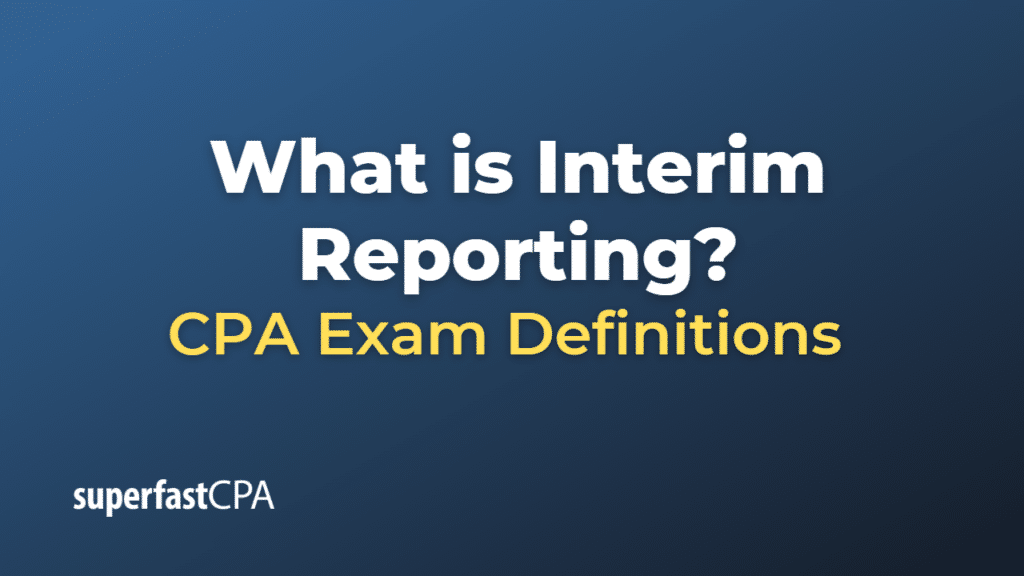Interim Reporting
Interim reporting is the practice of issuing financial statements by a company for a period shorter than a full fiscal year, typically on a quarterly or half-yearly basis. These interim financial statements provide investors, regulators, and other stakeholders with an update on the company’s ongoing financial performance.
Interim reporting generally includes the following financial documents:
- An interim income statement, which reports revenues, costs, and expenses to demonstrate the company’s profitability over the interim period.
- An interim balance sheet, which shows the company’s assets, liabilities, and equity at the end of the interim period.
- An interim cash flow statement, which outlines the company’s cash inflows and outflows from operating, investing, and financing activities during the interim period.
Some companies may also include a statement of changes in equity, notes to the financial statements, and management discussion and analysis (MD&A), depending on regulatory requirements and the preferences of management.
The primary goal of interim reporting is to provide timely information about a company’s financial health and operational performance. It allows stakeholders to make informed decisions without waiting for the annual financial statements.
However, interim reports are often unaudited and may rely more heavily on estimates than annual financial statements. Therefore, while they are valuable sources of information, they should be used in conjunction with other financial information for a comprehensive understanding of a company’s financial situation.
Example of Interim Reporting
Let’s imagine a hypothetical tech company named “TechOne, Inc.” that uses interim reporting to provide its stakeholders with quarterly financial updates.
Quarter 1 Interim Report for TechOne, Inc.
At the end of the first quarter (January to March), TechOne releases an interim report that includes the following:
Interim Income Statement
| Item | Amount ($) |
|---|---|
| Revenue | 2,500,000 |
| Cost of Goods Sold (COGS) | -1,000,000 |
| Gross Profit | 1,500,000 |
| Operating Expenses | -500,000 |
| Operating Income | 1,000,000 |
| Interest Expense | -50,000 |
| Pre-tax Income | 950,000 |
| Income Tax | -190,000 |
| Net Income | 760,000 |
Interim Balance Sheet
| Item | Amount ($) |
|---|---|
| Assets | |
| Cash | 500,000 |
| Accounts Receivable | 200,000 |
| Inventory | 300,000 |
| Total Assets | 1,000,000 |
| Liabilities | |
| Accounts Payable | 200,000 |
| Short-term Debt | 100,000 |
| Total Liabilities | 300,000 |
| Equity | |
| Common Stock | 500,000 |
| Retained Earnings | 200,000 |
| Total Equity | 700,000 |
| Total Liabilities + Equity | 1,000,000 |
Interim Cash Flow Statement
| Item | Amount ($) |
|---|---|
| Operating Activities | |
| Net Income | 760,000 |
| Adjustments to net income (Depreciation, etc.) | 50,000 |
| Changes in Working Capital | -30,000 |
| Net Cash from Operating Activities | 780,000 |
| Investing Activities | |
| Capital Expenditures | -200,000 |
| Net Cash used in Investing Activities | -200,000 |
| Financing Activities | |
| Dividends Paid | -80,000 |
| Net Cash used in Financing Activities | -80,000 |
| Net Change in Cash | 500,000 |
| Cash at Beginning of Period | 0 |
| Cash at End of Period | 500,000 |
This interim report would be made publicly available, usually on the company’s website and through regulatory filing systems. It provides a snapshot of TechOne’s performance during the first quarter, allowing stakeholders to stay informed about the company’s financial health and operations.













